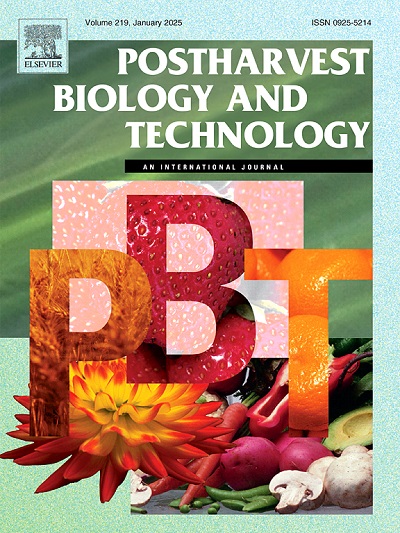Effects of exogenous strigolactones on tomato-fruit quality
IF 6.4
1区 农林科学
Q1 AGRONOMY
引用次数: 0
Abstract
The objective of this study was to investigate the effect of the synthetic analog of strigolactone, GR24 (SL), on the quality of tomato fruits. The surfaces of tomatoes (Solanum lycopersicum cv. Micro-Tom) fruits were treated with different concentrations of SL treatments. The following concentrations were used: 0 (CK), 0.1 (T1), 0.5 (T2), (T3), 2 (T4), and 3 μmol L−1 strigolactone synthesis inhibitor (Tis108). The experiment was conducted over 3 d, from the 24th to the 26th day after the fruit setting (mature green fruit stage). The results demonstrated that, after 24 d of treatment, the soluble solids in the T3 treatment exhibited a notable increase of 13.48 % compared to the CK. In addition, the contents of soluble protein and vitamin C demonstrated significant elevations of 46.74 %, 35.04 %, 1.36 %, and 1.40 %, respectively, compared to the CK and Tis108 treatments. Accordingly, T3 treatment was identified as the optimal SL concentration for investigating the impact of SL treatment on sensory, nutritional, and flavor quality during fruit ripening. SL treatment upregulated the gene expression of SlAI, SlNI, SlSPS, and SlSS in the sucrose metabolic pathway. In addition, it promoted an increase in acid invertase (AI), neutral invertase (NI), sucrose synthase (SS), and sucrose phosphate synthase (SPS) activities; accelerated the hydrolysis of sucrose; promoted the accumulation of fructose and glucose; and increased the total sugar content of fruits. Concurrently, SL treatment resulted in a notable reduction in the total acid content of the fruit, accompanied by an increase in the sugar-acid ratio. E-nose analysis also showed that SL treatment increased the characteristic aroma of fruits. In addition, the total amino acid content of tomato fruits was markedly enhanced following the SL treatment. On the 24th day, the total amino acid content of the SL treatment significantly increased by 16.04 % and 8.93 % compared to the CK and Tis108 treatments, respectively. Furthermore, the concentrations of phenolic acids and flavonoids in SL-treated fruits were markedly elevated compared to those observed in the CK and Tis108 treatments. SL has a considerable impact on enhancing the sensory quality, nutritional value, and flavor profile of tomato fruits.
求助全文
约1分钟内获得全文
求助全文
来源期刊

Postharvest Biology and Technology
农林科学-农艺学
CiteScore
12.00
自引率
11.40%
发文量
309
审稿时长
38 days
期刊介绍:
The journal is devoted exclusively to the publication of original papers, review articles and frontiers articles on biological and technological postharvest research. This includes the areas of postharvest storage, treatments and underpinning mechanisms, quality evaluation, packaging, handling and distribution of fresh horticultural crops including fruit, vegetables, flowers and nuts, but excluding grains, seeds and forages.
Papers reporting novel insights from fundamental and interdisciplinary research will be particularly encouraged. These disciplines include systems biology, bioinformatics, entomology, plant physiology, plant pathology, (bio)chemistry, engineering, modelling, and technologies for nondestructive testing.
Manuscripts on fresh food crops that will be further processed after postharvest storage, or on food processes beyond refrigeration, packaging and minimal processing will not be considered.
 求助内容:
求助内容: 应助结果提醒方式:
应助结果提醒方式:


